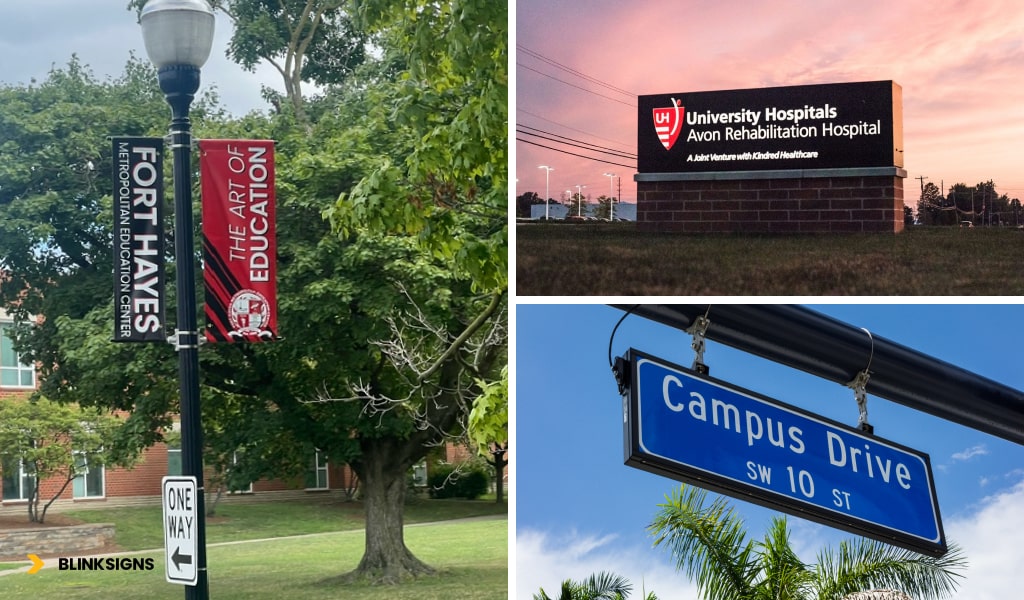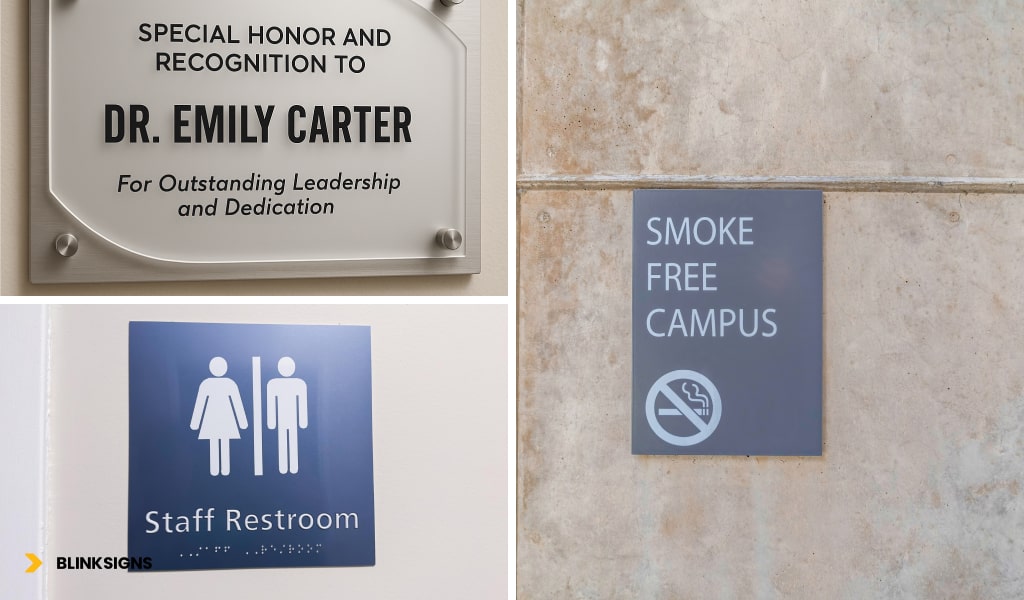
University Campus Signage Guide: Wayfinding, Legacy & Design
A Campus Experience Starts with Signage
A university visit is never just about finding a building- it’s about finding your place. Whether it’s a student navigating orientation, a family arriving for commencement, or a donor returning to see their name on a wall, every moment on campus matters.
But without clear signage, even the most beautiful campus can feel overwhelming.
At BlinkSigns, we design campus signage systems that do more than direct traffic. We help tell your campus story, visually, accessibly, and with pride. From intuitive wayfinding across sprawling academic buildings to elegant donor recognition walls that celebrate legacy, our signage solutions create clarity, comfort, and connection.
Let’s help every visitor feel welcomed the moment they arrive, and remembered long after they leave.
Wayfinding That Works Across Multiple Buildings

Wayfinding Signage That Works Across Multiple Buildings
Large university campuses often span multiple buildings, departments, and sometimes even multiple cities. That scale demands a strategic wayfinding system that simplifies navigation without sacrificing aesthetics or function.
At BlinkSigns, we specialize in designing and deploying campus-wide signage solutions that combine form, function, and compliance. Our wayfinding systems are engineered to do more than direct; they enhance the campus journey.
Why Multi-Building Campuses Need Signage Strategy
Campuses aren’t like shopping malls or office parks. They’re living, learning environments that must serve a diverse population, prospective students, current enrollees, faculty, families, alumni, and vendors. These individuals all navigate the campus differently, which is why signage must:
- Provide pedestrian and vehicular guidance across entry points, parking structures, and academic buildings.
- Offer multilingual, ADA-compliant directions for key areas like admissions, financial aid, student centers, and lecture halls.
- Support event-based wayfinding, from commencement ceremonies to campus tours.
Clear signage reduces frustration, supports safety, and makes a strong first impression, especially during admissions season, alumni events, or orientation weeks.
Types of Campus Wayfinding Signage
A successful signage system includes a combination of:
- Monument Signs at campus entrances to establish identity and presence.
- Directional Kiosks and Campus Maps that offer intuitive navigation and landmark references.
- Interior Directories, Department Markers, and Room ID Signage tailored to specific colleges or buildings.
- Temporary Event Signage for open houses, graduation ceremonies, and visiting scholars.
Each of these touchpoints must be visually aligned with the institution’s brand identity while remaining functional for all audiences.
ADA Compliance: Designing for Access and Equity

ADA Compliance_ Designing for Access and Equity
Signage that fails to meet accessibility standards isn’t just an oversight; it’s a violation of federal law and institutional values. ADA compliance ensures that every student, faculty member, and visitor can move through your campus with dignity and autonomy.
At BlinkSigns, we prioritize ADA compliance not as a final checklist, but as a foundation of every signage program.
Key ADA Signage Requirements for Campuses
- Grade 2 Braille and Tactile Lettering for permanent room and floor identifiers.
- High-contrast visuals with non-glare finishes for easy readability by users with low vision.
- Correct installation height and location for reachability by wheelchair users.
- Accessible route signs, including entrances, elevators, parking, and restrooms.
Neglecting these standards not only risks DOJ penalties, it also communicates exclusion. A compliant signage program reflects a university’s commitment to inclusion, equality, and leadership in accessibility.
Physical Signage Types That Shape Campus Navigation & Pride
Across sprawling university campuses, signage must perform multiple roles—guide, reassure, represent, and inspire. Here’s how each type contributes to a more navigable and welcoming environment:
| Sign Type | Purpose | Example Use Case |
| Exterior Wayfinding | Directs foot and vehicle traffic between buildings | Directional signs at intersections or parking lot entries |
| Monument & Gateway Signs | Creates campus identity and sets first impressions | University entrance signs, campus boundary markers |
| Building Identification | Labels each facility clearly for students and visitors | “Science Hall,” “Admissions Office,” or “Library” signage |
| Interior Directory Systems | Helps navigate within buildings | Lobby kiosks showing floors, departments, or room numbers |
| Changeable Letter Boards | Shares real-time campus news or event updates | Event halls or student union announcements |
| Digital Displays | Offers dynamic, multi-language, or emergency messaging | Student centers, food courts, lecture hall entrances |
| ADA-Compliant Signage | Ensures accessibility and legal compliance | Room IDs, elevator signs, and restroom wayfinding |
Donor Recognition Signage: Where Gratitude Meets Legacy
On many campuses, some of the most thoughtfully designed signs are those that recognize generosity. Donor walls and plaques do more than honor support; they inspire future giving, create emotional connection, and often mark a defining moment in a building’s story.
Common formats include:
- Architectural Donor Walls: Often placed in lobbies or atriums, these tell a visual story of giving, featuring layered materials like glass, brushed metal, or etched stone.
- Room & Wing Naming Plaques: Elegant markers outside classrooms, labs, or lecture halls honoring named gifts.
- Digital Donor Displays: Interactive touchscreens that evolve with new contributors and allow video or testimonial integration.
What makes donor signage most impactful is personalization. Using alumni quotes, milestone dates, or embedded narratives within the design helps tie the donor’s legacy directly to the student experience.
“Donor recognition signs aren’t just about names on walls,” says a Senior Designer at BlinkSigns. “They’re about storytelling, emotion, and inviting the next generation to make their mark.”
Permitting, Compliance & Institutional Consistency
Campuses often fall under multiple zoning and ADA regulations depending on the location, historic designation, and type of institution. At BlinkSigns, we ensure every sign, whether on a historic liberal arts campus or a modern STEM facility, is fully:
- ADA-Compliant (tactile characters, Braille, contrast, mounting height)
- Zoning Approved (campus-specific municipal codes for height, lighting, location)
- Institutionally Branded (aligned with existing font, color, and materials guidelines)
We maintain brand guides for each university partner, ensuring new signs uphold tradition while embracing innovation.
FAQs — University Campus Signage Explained
What types of signs are essential for a large university campus?
Key signage types include main entry monuments, directional/wayfinding signage, building ID signs, ADA-compliant room signs, parking and pedestrian flow signage, and donor recognition walls. Together, they support branding, navigation, accessibility, and campus engagement.
How does signage support campus wayfinding for first-time visitors and students?
Strategic campus signage makes complex university layouts feel intuitive. Clear building markers, pedestrian-friendly maps, and pathfinding to key locations (student centers, libraries, dorms) reduce confusion and improve the visitor experience—especially during orientation, open houses, or major events.
Can donor recognition signage be integrated with digital systems?
Yes. Donor walls can incorporate digital screens, QR code integrations, and touch-enabled kiosks to showcase donor stories, funding impact, and even real-time updates—while still aligning with traditional engraved plaques or etched glass panels.
What materials work best for long-lasting exterior campus signage?
Aluminum, stainless steel, routed HDU (high-density urethane), and stone bases are ideal for monument signs. These materials withstand weather extremes and require minimal maintenance, which is critical for high-traffic areas.
What is ADA-compliant signage and why does it matter in educational environments?
ADA-compliant signage ensures accessibility for all students, faculty, and visitors. It includes Braille, raised tactile letters, non-glare finishes, and correct installation height. Non-compliance can result in legal issues and prevent full campus participation for individuals with disabilities.
How do I begin a signage update for an existing university or college campus?
Start with a signage audit to evaluate what’s outdated, non-compliant, or inconsistent. Then develop a signage master plan that prioritizes entry points, navigation bottlenecks, and donor recognition. Partnering with a full-service firm like BlinkSigns helps you navigate design, permitting, fabrication, and installation from one centralized source.
Final Thoughts: Signage That Builds Connection and Campus Pride
A university campus isn’t just a physical space; it’s a community. Signage is what helps that space feel navigable, welcoming, and memorable for everyone who steps onto it.
At BlinkSigns, we design signage systems that guide the way, honor the past, and visually represent your institution’s future. From ADA‑compliant wayfinding to legacy-driven donor walls, every sign we create serves a purpose: to connect people to place, and to each other.
Ready to upgrade your campus signage and leave a lasting impression?
Let BlinkSigns lead the way. Contact us for a campus signage consultation.